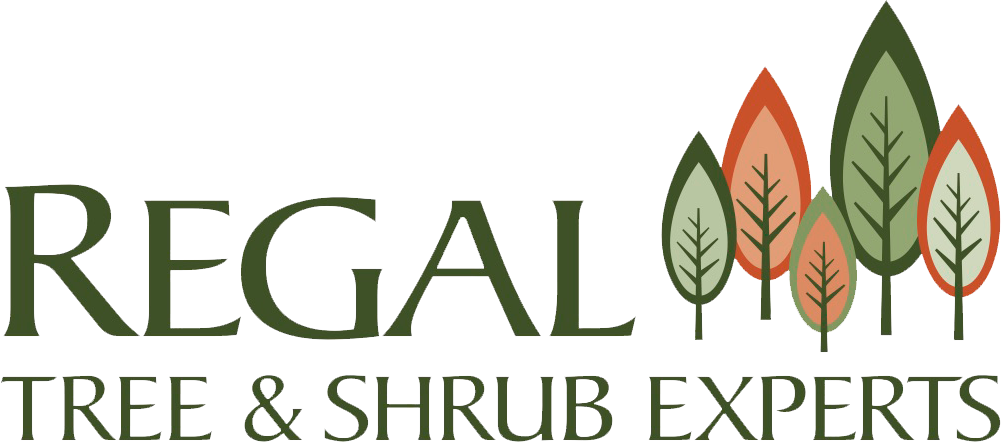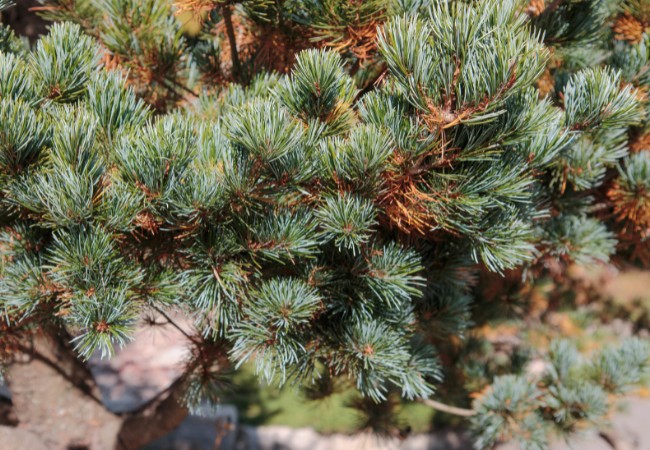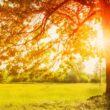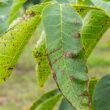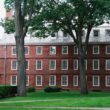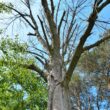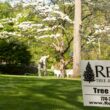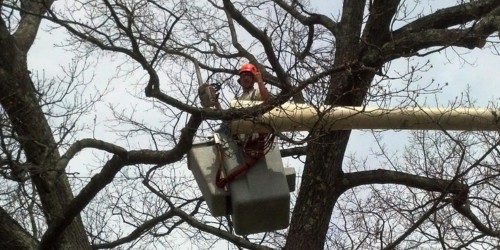When something looks off with your trees – whether its browning needles or entire branches dying – it can be hard to know what you’re actually dealing with. There are a lot of reasons a tree might not look right, but having an idea of what to watch for can help you figure out if it’s a minor issue or something more serious. Here are four common tree diseases we see here in Massachusetts and what you can do to catch and treat them early.
Key Takeaways:
- Beech leaf disease is a serious condition that causes dark bands on beech leaves and, while there’s no cure yet, it can be managed with nematicide sprays, injections, and phosphites.
- White pine needlecast causes reddish-brown needle discoloration on Eastern white pines and, although it looks bad, it’s rarely fatal and can be managed by an arborist.
- Anthracnose affects various trees (especially dogwoods and maples) during cool, wet spring conditions, causing leaf spots and discoloration.
- Apple scab affects apple and crabapple trees during warm, wet weather, causing dark spots on leaves and fruit.
4 Common Tree Diseases to Watch Out for in Greater South Easton
There are many diseases that threaten our Massachusetts trees. The damage they can do ranges from minor harm to the aesthetics of the tree or its flowers to killing the tree. Knowing what to look for and when to look for it could be the difference in getting your tree the help it needs before it’s too late.
Four diseases to look for include:
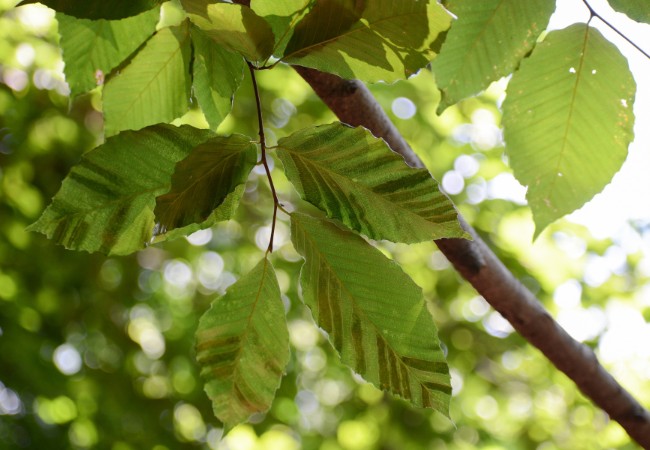
1. Beech Leaf Disease
Beech leaf disease (BLD) is a relatively new concern for Massachusetts residents, as it was first detected here Plymouth County in June 2020. This fatal disease targets our native American beech (Fagus grandifolia) trees that make up about 10 percent of all forest trees in Massachusetts. That’s almost 141 million trees in the latest survey!
The disease is caused by a microscopic nematode called Litylenchus crenatae ssp. mcannii (Lcm), causes BLD. Researchers are still learning how it spreads and how to treat it effectively. The nematode feeds on beech buds, damaging them over time.
One of the earliest and most recognizable signs of BLD is dark banding on the leaves. On a sunny day, you might notice distinct black stripes when looking up through the canopy. Other symptoms to watch for include:
- Cupping of the leaves or other distortion
- A leathery texture on leaves
- Premature leaf drop
- Dead buds
- Branch dieback
Saplings with BLD will quickly die, while mature trees may be able to survive for years.
Beech Leaf Disease Treatment and Prevention Information
There is no definitive cure for BLD, though there are several potential ways to treat trees, including foliar nematicide sprays, nematicide injections, and phosphites. If you are worried about your beeches, have an arborist examine them and make a recommendation for the prevention or treatment of BLD.
2. White Pine Needlecast
Eastern white pines (Pinus strobus) are some of the most common trees in our landscapes and natural environments in Massachusetts, which makes any threats they face a significant concern. Several fungi are responsible for white pine needlecast, which damages a pine’s foliage.
The first symptom of needlecast is a reddish-brown color on needles in late July. By the next spring, these needles will curl and develop a muted gray or tan color. Most discoloration happens at the tips of the needles rather than the base.
Needlecast is not typically fatal, and most of the damage is aesthetic.
White Pine Needlecast Prevention and Treatment Information
Keeping any white pines on your property in good health with tree preservation techniques, such as pruning, watering, and fertilization, is often the best method for preventing white pine needlecast. If the damage is severe, talk to an arborist and see if they recommend chemical controls.
3. Anthracnose
Anthracnose is a group of fungal diseases that affect many Massachusetts trees, with dogwoods (Cornus) and maples (Acer) being some of the most common in our area. Each fungus that causes anthracnose will only attack specific species of trees, so a dogwood with anthracnose can’t spread it to a nearby maple.
The disease primarily affects the leaves of trees, damaging them but rarely causing significant harm to the tree. Look for discolored spots or dead areas on your leaves to identify anthracnose. The damage is most common on lower branches.
The fungi that cause anthracnose spread in the spring when conditions become cool and wet. Splashing water helps move the fungi to new plants to infect, and wind aids in carrying it to leaves. The disease will continue to spread and affect leaves as long as the weather stays cool and wet. Anthracnose will stop spreading as soon as the temperatures rise and the dryness of summer sets in.
Anthracnose Prevention and Treatment Information
You won’t need to invest in fungicides to counter anthracnose in most cases. However, fungicides can protect your trees if the infection is severe or if the tree has been dealing with repeated infections.
Other actions to take to protect your tree include:
- Prune branches with leaves infected by anthracnose and dispose of the debris
- Rake up and destroy leaves in the fall to reduce the areas where the anthracnose fungi can overwinter
- Avoid spraying your tree’s canopy with water
- Plant species and cultivars that are resistant to the disease
4. Apple Scab
Growing apple trees on your property is a great way to enjoy fruit in the summer. However, apple scab can certainly throw a wrench into those plans.
Apple scab is a fungal disease that affects many types of apple and crabapple trees. Like anthracnose, there are different strains of the fungus, each targeting specific species.
The fungus spends the winter on fallen leaves and eventually releases spores into the air in the spring. The wind carries the spores to leaves and fruit to start the infection, causing spots to appear on infected material. The spots can then release spores to continue infecting other parts of the tree or other plants. Apple scab is typically a spring and summer stressor, as it thrives in warm and wet conditions.
Apple Scab Prevention and Treatment Information
“One of the most effective methods of controlling apple scab is to clean up leaves in the fall. Since the apple scab fungi overwinters in fallen leaves, we recommend you rake them up and destroy them before the first snow of the season. Or, if you have a mulching lawn mower, you can use that to destroy the leaves.” – Adam Winsor, Regal Tree Plant Health Care Manager
Another important step in controlling apple scab is to have a professional prune your apple trees correctly. They will leave enough space between each branch to increase air circulation. This will allow the inner portions of the canopy to dry faster and lower the risk of apple scab developing.
Fungicides are also useful when you have a high-value tree that you want to protect the fruit of.
Frequently Asked Questions About Massachusetts Tree Diseases
To help you protect your trees from diseases, we have answered some common questions from homeowners about dealing with diseases.
Are diseases the only thing I have to worry about with my Greater South Easton trees?
While tree diseases are a significant concern in Massachusetts, we also have to worry about the damage posed by pests like invasive insects. Insects and diseases may work together to harm your trees, making prevention and early intervention even more important.
Can I use fungicides on my trees myself, or should I hire a professional?
Most arborists do not recommend that homeowners use fungicides themselves for a few reasons. Without the proper qualifications, you won’t have access to the same variety of chemicals as professionals. Additionally, you may use the wrong dosage or apply them at the wrong time, harming the tree rather than helping it.
Should I have an arborist examine my trees in the summer for signs of disease?
Yes, we recommend inspecting trees in the summer, especially if they have previously dealt with infections. For most landscapes, an inspection schedule of every three to five years is acceptable, but you’ll want to increase the frequency if you have at-risk trees that you can’t afford to lose.
Regal Tree Can Help Protect and Treat Your Greater South Easton Trees
When you have a mature tree that adds a lot of natural beauty and value to your property, you need to do everything you can to protect it from diseases. Preventing diseases with systemic fungicide treatments, proper pruning, fertilization, and inspections is often much more cost-effective than attempting to treat the problem later. When you want to ensure someone does the job right, trust the team at Regal Tree.
Our team includes ISA Certified Arborists with a deep understanding of our local species and the diseases that affect them. We can suggest ways to protect or treat your trees once an infection is present. Call us today at 774-719-2450 or request a quote online for help with your sick trees.
